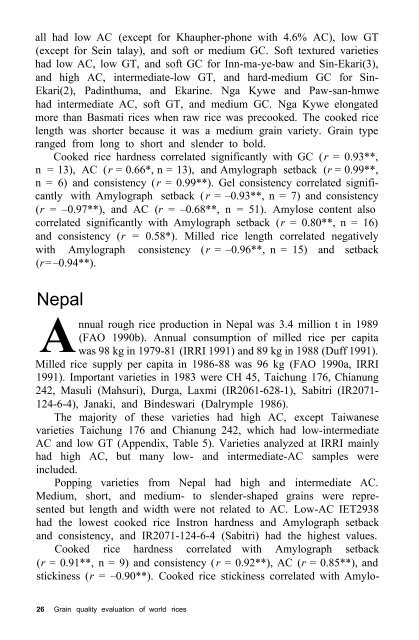Juliano et al. - 1993 - Grain Quality Evaluation of World Rices
Juliano et al. - 1993 - Grain Quality Evaluation of World Rices
Juliano et al. - 1993 - Grain Quality Evaluation of World Rices
Create successful ePaper yourself
Turn your PDF publications into a flip-book with our unique Google optimized e-Paper software.
<strong>al</strong>l had low AC (except for Khaupher-phone with 4.6% AC), low GT<br />
(except for Sein t<strong>al</strong>ay), and s<strong>of</strong>t or medium GC. S<strong>of</strong>t textured vari<strong>et</strong>ies<br />
had low AC, low GT, and s<strong>of</strong>t GC for Inn-ma-ye-baw and Sin-Ekari(3),<br />
and high AC, intermediate-low GT, and hard-medium GC for Sin-<br />
Ekari(2), Padinthuma, and Ekarine. Nga Kywe and Paw-san-hmwe<br />
had intermediate AC, s<strong>of</strong>t GT, and medium GC. Nga Kywe elongated<br />
more than Basmati rices when raw rice was precooked. The cooked rice<br />
length was shorter because it was a medium grain vari<strong>et</strong>y. <strong>Grain</strong> type<br />
ranged from long to short and slender to bold.<br />
Cooked rice hardness correlated significantly with GC ( r = 0.93**,<br />
n = 13), AC ( r = 0.66*, n = 13), and Amylograph s<strong>et</strong>back ( r = 0.99**,<br />
n = 6) and consistency ( r = 0.99**). Gel consistency correlated significantly<br />
with Amylograph s<strong>et</strong>back ( r = –0.93**, n = 7) and consistency<br />
( r = –0.97**), and AC (r = –0.68**, n = 51). Amylose content <strong>al</strong>so<br />
correlated significantly with Amylograph s<strong>et</strong>back ( r = 0.80**, n = 16)<br />
and consistency ( r = 0.58*). Milled rice length correlated negatively<br />
with Amylograph consistency ( r = –0.96**, n = 15) and s<strong>et</strong>back<br />
( r= –0.94**).<br />
Nep<strong>al</strong><br />
A<br />
nnu<strong>al</strong><br />
rough rice production in Nep<strong>al</strong> was 3.4 million t in 1989<br />
(FAO 1990b). Annu<strong>al</strong> consumption <strong>of</strong> milled rice per capita<br />
was 98 kg in 1979-81 (IRRI 1991) and 89 kg in 1988 (Duff 1991).<br />
Milled rice supply per capita in 1986-88 was 96 kg (FAO 1990a, IRRI<br />
1991). Important vari<strong>et</strong>ies in 1983 were CH 45, Taichung 176, Chianung<br />
242, Masuli (Mahsuri), Durga, Laxmi (IR2061-628-1), Sabitri (IR2071-<br />
124-6-4), Janaki, and Bindeswari (D<strong>al</strong>rymple 1986).<br />
The majority <strong>of</strong> these vari<strong>et</strong>ies had high AC, except Taiwanese<br />
vari<strong>et</strong>ies Taichung 176 and Chianung 242, which had low-intermediate<br />
AC and low GT (Appendix, Table 5). Vari<strong>et</strong>ies an<strong>al</strong>yzed at IRRI mainly<br />
had high AC, but many low- and intermediate-AC samples were<br />
included.<br />
Popping vari<strong>et</strong>ies from Nep<strong>al</strong> had high and intermediate AC.<br />
Medium, short, and medium- to slender-shaped grains were represented<br />
but length and width were not related to AC. Low-AC IET2938<br />
had the lowest cooked rice Instron hardness and Amylograph s<strong>et</strong>back<br />
and consistency, and IR2071-124-6-4 (Sabitri) had the highest v<strong>al</strong>ues.<br />
Cooked rice hardness correlated with Amylograph s<strong>et</strong>back<br />
( r = 0.91**, n = 9) and consistency ( r = 0.92**), AC ( r = 0.85**), and<br />
stickiness ( r = –0.90**). Cooked rice stickiness correlated with Amylo-<br />
26 <strong>Grain</strong> qu<strong>al</strong>ity ev<strong>al</strong>uation <strong>of</strong> world rices

















